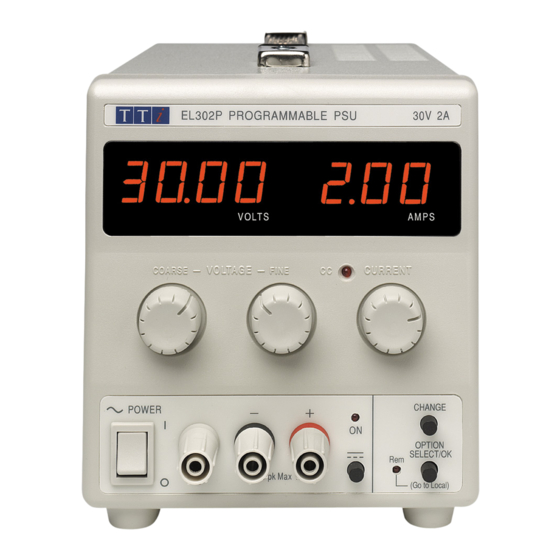
Publicité
Les langues disponibles
Les langues disponibles
Liens rapides
Publicité

Sommaire des Matières pour Aim TTi EL302P
- Page 14 Sécurité Cet instrument est de Classe de sécurité 1 suivant la classification IEC et il a été construit pour satisfaire aux impératifs EN61010-1 (impératifs de sécurité pour le matériel électrique en vue de mesure, commande et utilisation en laboratoire). Il s'agit d'un instrument d'installation Catégorie II devant être exploité...
- Page 15 Installation Tension d’utilisation secteur Vérifier que la tension opérationnelle de l'instrument indiquée sur le panneau arrière est appropriée pour l'alimentation locale. S'il s'avère nécessaire de modifier la tension opérationnelle, procéder de la manière décrite ci-dessous: S'assurer que l'instrument est débranché de l'alimentation c.a. Enlever les vis de retenue de la partie supérieure du boîtier et de la manette et soulever la partie supérieure du boîtier.
- Page 16 Connexions Bornes de sortie Toutes les connexions d’alimentation s’effectuent à partir du panneau avant. Relier la charge aux bornes positive (rouge) et négative (noire) marquées OUTPUT (Sortie). Les deux sont entièrement flottantes et l'une ou l'autre peut être connectée à la masse. La borne désignée est reliée au châssis et à...
- Page 17 alimentations de précision sur banc, un condensateur est relié aux bornes de la sortie, afin de maintenir la stabilité, ainsi qu’une bonne réponse transitoire. Ce condensateur se charge jusqu’à la tension de sortie, et le court-circuitage de la sortie produira une impulsion de courant, lors du déchargement du condensateur indépendamment du réglage de limite de courant.
- Page 18 Fonctionnement à distance Le format des commandes à distance et les commandes à distance elles-mêmes sont détaillés dans le chapitre Commandes à distance. Sélection de la vitesse de transmission Appuyer sur le bouton OPTION SELECT/OK jusqu'à ce que apparaisse dans l'affichage bAUd de gauche permet de régler la vitesse de transmission ;...
- Page 19 Connecter à un PC avec un câble comportant les broches 2, 3, 5 câblées plus les broches 1, 4, 6 et les broches 7 et 8, reliées côté PC, voir le schéma. La vitesse de transmission est réglée comme décrit plus haut ; les autres paramètres de l'interface sont fixés comme suit : Bits de départ : 1 Parité...
- Page 20 Commandes à distance Formats des commandes à distances RS232 Le tampon d'entrée de l'instrument accepte une seule commande (ou interrogation) à la fois, sous interruption, d'une manière transparente pour les autres opérations de l'instrument. Les commandes et interrogations doivent être envoyées comme spécifié dans la liste des commandes et doivent se terminer par le code de fin de commande 0AH (saut de ligne, LF).
- Page 21 Renvoie la limite d’intensité de sortie réglée en A sous le format numérique <nr2>. La syntaxe de la réponse est I<nr2><rmt> Exemple : Si la limite d’intensité de sortie réglée est de 1,00 A, la réponse à la commande I? sera I 1.00<rmt>. Lit et renvoie la tension réelle de sortie en Volts sous le format numérique <nr2>.









